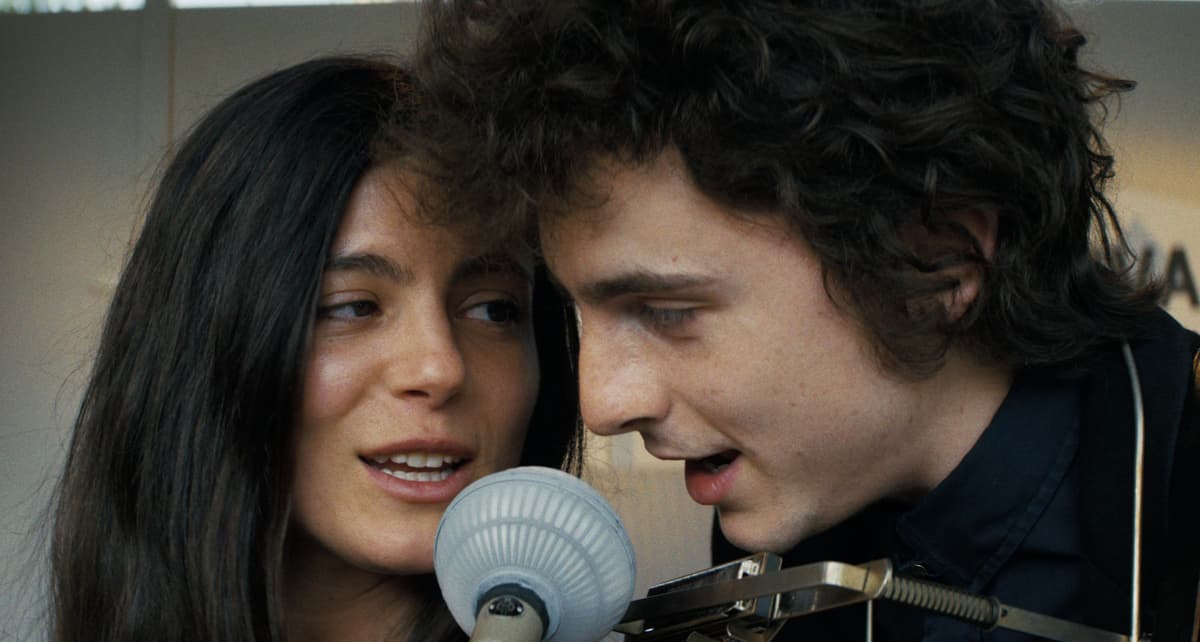Timothée Chalamet Growls to Greatness as Bob Dylan in ‘A Complete Unknown’
The fast-rising actor passes the test of inhabiting a legend — like a rolling stone.

The actor Timothée Chalamet can ride a sandworm, but how is he with a harmonica? That’s the question posed by his turn as the musician Bob Dylan in “A Complete Unknown,” from director James Mangold. Its subject is the heady stretch from Mr. Dylan’s arrival at Greenwich Village in 1961 to his conversion to electric music at the 1965 Newport Folk Festival. Mr. Chalamet passes the test like a rolling stone.
As the singer Joan Baez — here played with wary charisma by Monica Barbaro — put it in her song “Diamonds and Rust,” Mr. Dylan “came on the scene already a legend.” Born Robert Zimmerman, the grandson of Jews who fled pogroms at Odessa, the future Nobel Laureate in Literature was raised at Hibbing, Minnesota. He dropped out of college and traveled east to visit his idol Woody Guthrie, hospitalized by the ravages of Huntington’s.
“A Complete Unknown” begins with Dylan paying hospital homage to Guthrie and folk music’s mentor, Pete Seeger,* played with depth and pathos by Edward Norton. The young musician wants to “catch a spark” off of the older ones. Seeger asks him to play a song, and Dylan strums out “Song to Woody.” Mr. Norton registers a storm of emotions — pleasure, surprise, and a wariness born of a dawning recognition of an obliterating talent.
Mr. Chalamet, festooned with curls and occluded by sunglasses, is a convincing Dylan. He sings the songs himself, and understands that there is no getting backstage with the bard — he is remote, strange, accountable only to the verses that come in the dawn or the black of night. His human touch is brusque, his Muse jealous. His girlfriend Sylvie (Elle Fanning) shares Chinese takeout with him and recommends he read the critic Dwight Macdonald.
The gathering force of Dylan’s stardom, though, breaks that relationship, just as it does his intermittent affair with Baez. Like Seeger, she sees that his arrival will change everything. There is tenderness — they sing “Blowing in the Wind” in bed, guitar vibrating against bare skin — but also the brutal force of a talent that is exhilarating but tidal. “The Times They Are A-Changin’” summarizes an era — and its restless soundtrack.
Mr. Dylan has spent decades making his own myth — in the movie, he tells Sylvie and Joan that he learnt his craft at the carnival. That was a lie, but it is true, as the musician Robyn Hitchcock writes, that many of his songs live in a “sad, doomed kingdom.” He lets down the people who love him — Seeger and Sylvie most of all — but the payoff is lines like this one, from “Visions of Johanna”: “The ghost of electricity howls through the bones of her face.”
“A Complete Unknown” is not the first film in recent years to take Mr. Dylan for its subject. The Coen brothers’ “Inside Llewyn Davis” unfolds in the same milieu of Greenwich Village, and Todd Haynes’s “I’m Not There” enlists a cadre of actors — Heath Ledger, Christian Bale, and Cate Blanchett among them — to play the baffling bard. “A Complete Unknown” eschews the postmodern conceit but retains what is fugitive about the songster.
Viewers will exit the movie, which runs for nearly two and a half hours, without the satisfaction of understanding Mr. Dylan. That would be impossible, anyway, and Mr. Mangold wisely does not try. What he does do, though, is offer an account of a world thrown off balance by the gravitational pull of absolute talent. What happens to an Antonio Salieri when, say, Wolfgang Amadeus Mozart shows up? A tragedy in the recognition of being second-rate.
“A Complete Unknown” captures these serious notes, but its frames are flush with pleasure. Baez’s eyes calibrate and crave Dylan. The Gaslight Cafe, which closed in 1971, is rendered with care. The music sounds fantastic, and the actors are strong from top to bottom. Ms. Fanning is especially compelling as a woman who loves and leaves Dylan, and Boyd Holbrook delivers a memorable Johnny Cash, a kind of degenerate older brother for the precocious Dylan.
The film’s climax is the mayhem that broke out at Newport in 1965 when Mr. Dylan went electric and played “Maggie’s Farm” and “Like a Rolling Stone” to the folk faithful. The movie’s momentum, though, argues that a break was inevitable. Robert Zimmerman could not be contained. The albums that followed — “Highway 61” and “Blonde on Blonde” — carry what he once called the “roar of a wave that could drown the whole world.”
________
* It was a correspondent for the Sun, Ron Radosh, who brought in the scoop that Seeger, a longtime lion of the left, came to regret his failure to confront Stalin.

